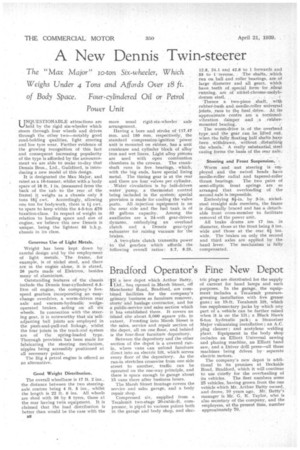A New Dennis Twin-steerer
Page 44

If you've noticed an error in this article please click here to report it so we can fix it.
UNQUESTIONABLE attractions are held by the rigid six-wheeler which steers through four wheels and drives through the other two—notably good road-holding qualities, light steering and low -tyre wear. Further evidence of the growing recognition of this fact and consequent increasing popularity of the type is afforded by the announcement we are able to make to-day that Dennis Bros., Ltd., Guildford, is introducing a new model of this design.
It is designated the Max Major, and rated as a 10-tanner, whilst with .a body space of 18 ft. 1 in. (measured from the back of the Cab to the rear of the frame) it weighs as a chassis only 3 tons 181 cwt, Accordingly, allowing one ton for bodywork, there is 11 cwt. to spare to keep within the 4-5-ton £70 taxation-class. In respect of weight in relation to loading space and size of engine, we believe this new Dennis is unique, being the lightest 95 b.h.p. chassis in its class.
Generous Use of Light Metals.
Weight has been kept down by careful design and by the employment of light metals. The frame, for example, is of nickel steel, and there are in the engine alone, it is stated, 26 parts made of Elektron, besides many of aluminium.
Outstanding features of the chassis include the Dennis four-cylindered 6.5litre oil engine, the company's fivespeed gearbox incorporating an easychange overdrive, a worm-driven rear axle and vacuum-hydraulic wedgeoperated brakes, acting on all six wheels. In connection with the steering gear, it is noteworthy that six 'selfadjusting hall joints are employed in the push-and-pull-rod linkage, whilst the four joints in the track-rod system are of the spring-loaded type. Thorough provision has been made for lubricating the steering mechanism, nipples being accessibly positioned at all necessary points.
The Big 4 petrol engine is offered as an alternative.
Good Weight Distribution.
The overall wheelbase is 17 ft. 2 ins., the distance between the two steeringaxle centres being 4 ft. 5 ins., whilst the length is 22 ft. 6 ins. All wheels are shod with 36 by 8 tyres, those at the rear having twin equipment. It is claimed that the load distribution is better than would be the case with the s8 more usual rigid-six-wheeler axle arrangement.
Having a bore and stroke of 117.47 mm. and 150 ann, respectively, the standard compression-ignition power unit is mounted on rubber, has a unit crankcase and cylinder block of alloy iron and wet liners. Light alloy pistons are used with open combustion chambers in the crowns. The crankshaft runs in five bearings, which, with the big ends, have special lining metal. The timing gear is at the rear and there are four valves per cylinder.
Water circulation is by belt-driven water pump, a thermostat control being included in the system; special provision is made for cooling the valve ports. All Injection equipment is on the near side and the fuel tank is of 33 gallons capacity. Among the • auxiliaries are a 24-volt gear-driven dynamo, embodying an overload clutch and a Dennis gear-type exhauster for raising vacuum for the brakes.
A two-plate clutch transmits power • to the gearbox which affords the following overall ratios : 5.7, 8.25, 12.8, 24A and 42.8 to 1 forwards and 55 to 1 'reverse. The shafts, which run on ball and roller bearings, are of large diameter and all gears, which have teeth of special form for silent running, are of nickel-chrome-molybdenum steel. , Thence a two-piece shaft, with rubber-bush and needle-roller universal joints, runs to thT final drive. At its approximate centre are •a torsionalvibration damper and ,a ru bbermounted bearing.
The worm-drive is of the overhead type and the gear can be lifted out,
• when the fully floating half shafts have been withdrawn, without . disturbing• the wheels.' A really substantial steel casing forms the basis of the rear axle.
• Steering and Front Suspension.
Worm and nut steering is employed and the swivel heads have needle-roller radial and tapered-roller
thrust bearings. The two pairs of semi-elliptic front springs are so arranged that overloading of the• second axle is impossible.
Embodying 81-in. by 3-in, nickelsteel straight side members, the frame is diagonally braced and has a detachable front cross-member to facilitate removal of the power unit.
All brake drums are 17 ins, in diameter, those at the front being 3 ins. wide and those at the rear 61 ins. wide. The brakes on only the second and third axles are applied by the hand lever. The mechanism is fully compensated.






































































































































